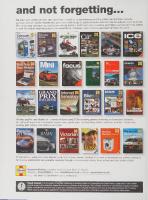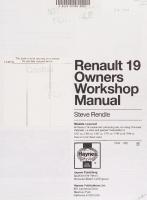Haynes Renault 18 Owners Workshop Manual 0856965987, 9780856965982
“187 pages : 28 cm Includes index”.
127 32
English Pages 196 Year 1982
Recommend Papers
File loading please wait...
Citation preview
979 to 1981 All models 1 1397 cc 5 1647cc
(Terry Davey)
|
|
=
Renault 18 Owners Workshop Manual John Fowler Models covered Renault 18 TL, GTL, TS and GTS models, Saloon and Estate, 1397 cc and 1647 cc
ISBN
O 85696
598
7
© Haynes Publishing Group 1982, 1983 7
All rights reserved. No part of this book may be reproduced or transmitted in
ABCDE
any form or by any means, electronic or mechanical, including photocopying,
Kno
recording or by any information storage or retrieval system, without permission in writing from the copyright holder.
Printed in England
(598 - 8H7)
HAYNES PUBLISHING GROUP SPARKFORD YEOVIL SOMERSET distributed in the USA by
HAYNES PUBLICATIONS 861 LAWRENCE DRIVE NEWBURY PARK CALIFORNIA 91320 USA
INC
BA22 7JJ ENGLAND
Acknowledgements Thanks are due to Régie Renault for the supply of technical information and certain illustrations, to Castrol Limited who supplied lubrication data, and to the Champion Sparking Plug Company who supplied the illustrations showing the various spark plug conditions.
About
The bodywork repair photographs used in this manual were provided by Holt Lloyd Ltd-who supply Turtle Wax’, ‘Dupli-color Holts’ and other Holts range products, and Sykes Pickavant Limited provided some of the workshop tools.
this manual
[ts aim The aim of this manual is to help you get the best from your car. It can do so in several ways. It can help you decide what work must be done (even should you choose to get it done by a garage), provide information on routine maintenance and servicing, and give a logical course of action and diagnosis when random faults occur. However, it is hoped that you will use the manual by tackling the work yourself. On simpler jobs it may even be quicker than booking the car into a garage and going there twice to leave and collect it. Perhaps most important, a lot of money can be saved by avoiding the costs the garage must charge to cover its labour and overheads. The manual has drawings and descriptions to show the function of the various components so that their layout can be understood. Then the tasks are described and photographed in a step-by-step sequence so that even a novice can do the work.
/ts arrangement The manual is divided into twelve Chapters, logical sub-division of the vehicle. The Chapters are Sections, numbered with single figures, eg 5; and paragraphs (or sub-sections), with decimal numbers the Section they are in, eg 5.1. 5.2 etc.
Introduction
each covering a each divided into the Sections into following on from
It is freely illustrated, especially in those parts where there is a detailed sequence of operations to be carried out. There are two forms of illustration: figures and photographs. The figures are numbered in sequence with decimal numbers, according to their position in the Chapter — Fig. 6.4 is the fourth drawing/illustration in Chapter 6. Photographs carry the same number (either individually or in related groups) as the Section or sub-section to which they relate. There is an alphabetical index at the back of the manual as well as a contents list at the front. Each Chapter is also preceded by its own individual contents list. References to the ‘left’ or ‘right’ of the vehicle are in the sense of a person in the driver's seat facing forwards.
Unless otherwise stated, nuts and bolts are removed by turning anti-clockwise, and tightened by turning clockwise. Vehicle manufacturers continually make changes to specifications and recommendatians, and these, when notified, are incorporated into our manuals at the earliest opportunity. Whilst every care is taken to ensure that the information in this manual is correct, no liability can be accepted by the authors or publishers for loss, damage or injury caused by any errors in, or omissions from, the information given.
to the Renault
18
——————————————————— The Renault 18 was first introduced to the French market in April 1978, and became available in the UK in February 1979. It combines a spacious and aerodynamically
designed
bodyshell with thoroughly
proven power units and transmissions. The 18TL and 18GTL vehicles are powered by a 1397 cc engine, with the GTL being the more highly equipped. The power unit fitted to the 18TS and 18GTS is of 1647cc with an aluminium cylinder block, and the GTS is equipped with electrically-operated front windows, electro-magnetic door locking, headlamp washer/wipers, tinted windows, and high quality seating and carpets. A four- or five-speed manual gearbox is used depending upon the version chosen; automatic transmission is also available. The transmission is mounted in line with and behind the engine, and also houses the differential unit which transmits the drive to the front wheels.
Front suspension’ is a double wishbone independent system, whilst at the rear a rigid axle with coil springs is employed. Telescopic shock absorbers and anti-roll bars are fitted front and rear. Rack-and-pinion steering is fitted, and braking is by a double hydraulic circuit system, with a pressure limiting valve in the circuit to the rear wheels to prevent locking of the wheels in an emergency stop situation. Discs are fitted at the front and drums at the rear, and servo assistance is provided.
The body incorporates features developed in the Renault Basic Research Vehicle, and the result is a very strong body structure incorporating many safety features. An Estate version is available, the 18TL with a 1397 cc engine and the 18TS with the 1647 cc unit. The 18TS is also available with automatic transmission.
Page
Acknowledgements
2
About this manual
2
Introduction to the Renault 18
2
Dimensions and weights
6
Buying spare
parts and vehicle identification numbers
Tools and working facilities
wo
Jacking and towing
11
Recommended
13
lubricants and fluids
Safety first!
14
Routine maintenance
15
Fault diagnosis
18
Chapter
1 Engine
Ze
Chapter 2 Cooling system
53
Chapter 3 Fuel and exhaust systems
57
Chapter 4 Ignition system
69
Chapter 5 Clutch
ad
Chapter 6 Manual
transmission
81
Chapter 7 Automatic transmission
101
Chapter 8 Driveshafts
107
Chapter 9 Braking system Chapter
10
Electrical system
Chapter
11
Suspension
%
and steering
Se
109 121 be
:
147
eee
Chapter 12 Bodywork and fittings IEE EEEE EEE Eee
163 eee
Conversion factors er
183
Index
184
|
“gh
ie
coma .
ene ge Be ait
Ceeet |as a gem gett te rR
yneuey SL 119 uoojes
9183S9
TL SL yineusy
Dimensions
and weights
Dimensions Overall length, approx: SOON Hes scceate es cier cee
a cna tects nas eteses settee vasvie octane oten ee oot
nc sup rrcuessazasagess
14 ft 44 in (4.38 m) 14 ft 74 in (4.46 m)
Overall, Wicthijielp pron esrvs cncenstvet es trees sence ascot aatv acs sgstvesarantervas sack oatewaranevaceavsrvsseveees Overall Hight eaMO ivcercctaxeseteenccensWeascasatevaees eventqateateurataeh tesaracsescuiséntsraesapeeet WV eelase saceeeraranssavssesdetysds cesses vuesanas doveshenacautunestabtasndes aaycrustaviebatacpttessvaptexdene FROME StraCK Ger, epressens sesccortosOevnesrch










